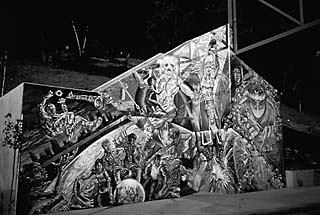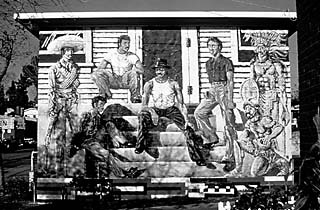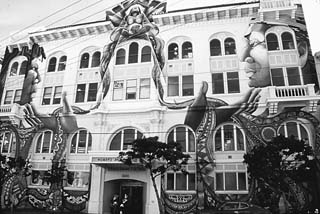|
Murals are the art form that reflect most clearly any changes in the
sociopolitical environment. From the time of the Renaissance, murals
have laid out in visual form the ideology of their sponsors, be it the
Church, the government, a powerful opposition, or simply private patrons.
After the Mexican Revolution of 1917, when the new government desired
to promulgate its revised version of Mexican history, muralism was revived
as a means of visually representing the point of view of "the revolution."
Artists were commissioned to adorn public buildings with heroic images
of the newly victorious underclass and its cultural history, pre-conquest
civilization. In its new role as a tool of historical revisionism and
cultural reclamation, murals have accompanied 20th-century anti-colonialist
and anti-bourgeois revolutionary movements around the world, though
never again with the kind of massive government support that existed
in Mexico in the 1920s.
Muralism was revived in the United States by the example of three great
Mexican muralists: Diego Rivera, José Clemente Orozco, and David
Alfaro Siqueiros.1 These three renowned artists came to the United States
in the early 1930s when a more conservative government took power in
Mexico and reduced its government patronage. During the Depression years,
United States artists inspired by the Mexicans persuaded Franklin Delano
Roosevelt to begin a mural program as part of the New Deal, but with
a few exceptions, the works were unprovocative and unremarkable. Nevertheless,
their presence in post offices and public buildings, as well as the
Mexican precedent, helped provide the impetus for the community mural
movement of the 1960s, which accompanied the strikes, marches, and demonstrations
of the Civil Rights and anti-war movements.
Unlike all previous mural movements, which were government sponsored,
the community murals of the late 1960s began as an arm of struggle--unfunded
and unofficial--a way of claiming urban space for a particular group
or point of view. From the beginning, a large proportion of the artists
were professionals, often young art school graduates from African American
and Mexican American backgrounds, or European American New Left activists,
using their skills to aid political movements. These trained artists
worked with neighborhood residents and youth to create murals and to
stimulate self-taught artists to join the mural movement.
In the case of Chicano murals, the catalyzing event was the United
Farm Workers (UFW) union organizing drive and a corresponding cultural
movement toward a politically defined identity. While posters and banners
were important elements of new militant art, the use of the mural form
was encouraged by the existence of a strong Mexican mural tradition.2
In the same way that the Chicano movement itself developed in two overlapping
directions, one emphasizing cultural identity and the other political
action, the imagery of early murals was drawn from both of these sources.
Imagery in cultural murals included copies of Mayan murals, pyramids,
Olmec sculptures, Indians (historical, mythical, and Hollywood), the
tripartite head (Indian, Spanish, and Mestizo), and religious motifs,
particularly the Virgin of Guadalupe. Political murals tended to emphasize
Mexican history, oppressed workers, portraits of political leaders like
Cesar Chavez and Reies Lopez Tijerina, as well as Emiliano Zapata and
"Pancho" Villa--heroes of the Mexican revolution. Solidarity figures
from other revolutions, like Ché Guevara and Martin Luther King,
Jr., were also frequently depicted. At Chicano demonstrations, the UFW
flag and the Virgin of Guadalupe were omnipresent as identifying icons.
These early murals, filled with political and cultural imagery, were
similar in origin and themes to the republican murals of the north of
Ireland. Chicano mural painters, however, even from the beginning, placed
much more emphasis on artistic quality and complex painting. This was
due to the large proportion of professionally trained artists involved
in mural making, the importance and popularity of the Mexican mural
tradition, and its wide dissemination to those with less skill. For
example, the film Walls of Fire, about the murals of Siqueiros, was
widely shown during this period, and many murals borrowed heavily from
this source. Also, from the early 1970s, some monies were available
to pay muralists (or at least buy supplies) through grass-roots fundraising,
small grants, and creative use of anti-poverty and social service funds.
Another difference between the Irish republican murals and the Chicano
walls, even in this early period, was the need of the Chicano movement
to address internal problems like gang violence, drugs and other self-destructive
behavior attributed to racism and poverty, while at the same time continuing
the struggle against external oppressive forces. Muralists approached
this issue in several ways. There were impassioned pleas against the
constant killings, like "To ace out a home boy from another barrio is
to kill La Raza," as well as murals painted by youth gangs to honor
the dead and mark a truce. At the same time, there were works glorifying
street culture: pachuco and pachuca style, low rider cars, graffiti,
Spanglish, and "bad taste," like the use of garish color combinations.3
These works were aimed at raising self-esteem and combating racist stereotypes
by glorifying precisely what was condemned by mainstream America.
During this early, nationalist period, 1970&endash;75, monocultural
groups predominated. Although Chicano muralists from one city would
often help out others in big projects, there was little racial mixing
during this period. At Chicano Park in San Diego, for example, land
underneath the Coronado Bay Bridge was taken by militants for a people's
park in 1970. Part of the plan was to muralize the freeway pillars.
During the first few years, several freeway offramps, walls, and pillars
were painted by local artists and residents and later by artists from
Sacramento. But until 1977, all the artists involved in the San Diego
project were Latino.4 In Los Angeles, mural projects were organized
in two housing projects, Ramona Gardens and Estrada Courts. All of these
projects were locally controlled and funded during this period with
the assistance of the community arts centers (like Centro Cultural de
la Raza in San Diego, or the Mechicano Art Center and Goez Gallery in
Los Angeles), which organized these activities.
Some of the self-taught artists found the mural medium compatible with
their abilities, and felt that their work was of immense value to the
local community, which led to their identification as muralists. In
1976, the first national meeting of these self-identified muralists
took place in New York City. This sense of identity, of belonging to
a larger group, was reinforced by the publication of a newsletter and
two books from inside the movement.5 There are some indications that
such an incipient identification of wall painters as muralists may also
be occurring in Northern Ireland. In his book Drawing Support: Murals
in the North of Ireland, Bill Rolston describes the work of one such
artist, Gerard Kelly. While spending time in prison as a POW, Kelly
studied art and began to paint murals on his release --he is now responsible
for a considerable number of outstanding murals in his neighborhood.
As Kelly says, ". . . most people like art . . . people would stand
and look at a mural before they would read a paper. Also, it gives the
people of the immediate area a sense of pride."6 Such artists tend to
continue to paint murals beyond the struggle period and transform a
momentary explosion into a continuing people's art movement. When the
heat of the Chicano movement (and the New Left opposition in general)
began to cool in the mid-1970s, many of the artists who had been involved
in militant work began to move towards more personal expressions and
reintegrate into the gallery system. Others who had identified as muralists
felt the power of their work in the community in terms not only as a
call to struggle, but also as fulfilling a need for relevant art in
ordinary people's lives that spoke to their pride and their neighborhood.
If Irish muralists continue to create community art beyond the peace,
perhaps this pattern will be duplicated in Ireland.
As muralists moved away from militant imagery (following the general
mood of a post-Vietnam society) toward portrayals of self-pride and
unity, the nationalist phase of the mural movement ended and the institutional
phase began. Murals had become respectable. They were funded by grants
from the new National Endowment for the Arts, which had a special program
to encourage community arts organizations, city funds, and, briefly
but massively, from CETA (Comprehensive Employment Training Act). These
latter funds were abruptly terminated with the election of Ronald Reagan
in 1980. CETA hired unemployed artists to set up public-service-oriented
arts service organizations in cities throughout the country. This general
employment program was responsible for a great influx of new artists
to the field of community murals. The new mural organizations were multiethnic,
and because city funds were often involved, mural content was controlled.
More often than not, this was through self-censorship and community
requests for noncontroversial subject matter rather than government
interference. Positive images of unity, ethnic pride, and history were
the most common themes, although whales and other environmental issues
formed an important subgroup.
Typical of these new organizations was SPARC (Social and Public Art
Resource Center), headed by Chicana muralist Judy Baca, which used public
funds along with private grants to finance murals by artists from various
ethnic and racial backgrounds. In 1976, Baca and SPARC began a massive
project that reflected the new multicultural emphasis. The Great Wall
of Los Angeles is devoted to the experience of different ethnic groups
in the history of California. It covers more than a half mile of the
wall along a concrete flood control channel and, under the supervision
of Baca, was painted over five summers by large crews of ethnically
and culturally diverse artists and teenagers. Since 1989, SPARC has
managed a city-funded mural program, Neighborhood Pride, which has produced
six to ten new murals each year in different ethnic communities of Los
Angeles.
Although community murals had become an accepted art form by the mid-1970s,
there was still a significant split between minority, mainly Chicano
and black artists, and a more art world-oriented group of "public artists"
who were working in abstract and photorealist styles that were being
incorporated into "urban renewal" and downtown revitalization projects.
By the mid-1980s, with the decline of an activist political base and
the introduction of significant funds to public art (as more and more
cities passed laws mandating that up to one percent of the costs of
new city construction and renovation be spent on art), community muralists
began to compete for city projects.
This movement out of the neighborhoods and into the mainstream corresponded
to the increasing professionalism of muralism, and the desire of artists
to have the opportunity to create major and permanent works. In Los
Angeles, this process was more successful than in most other cities,
helping to make it the "Mural Capital of the World." During the 1984
Olympic Games, ten of the established community muralists--Chicano,
black, and white--were commissioned to paint murals on downtown freeway
walls, thereby bringing the murals to the attention of middle-class
residents and visitors from around the world--most of whom would never
travel into the neighborhoods where the early masterpieces had been
painted. Murals became one of the tourist attractions of the city, a
source of "neighborhood pride," and a deterrent to graffiti and gang
violence. As such, they continued to receive substantial funds and support,
even as the recession of the late 1980s forced cutbacks in cultural
funds in many other cities.
In the twenty-five years since the heyday of the Chicano movement,
the melting pot analogy of American society has given way to a "salad
bar-style" celebration of multicultural diversity. Concurrently, the
art world has gone from favoring minimalism and hard-edge abstraction
to espousing postmodern eclecticism with exhibitions of gender, identity,
and politics. The once revolutionary idea that community residents should
have some say about the art placed in their neighborhood has become
incorporated into the selection process of almost all public art programs.
Finally, some community artists are receiving a share of the large commissions
that make possible really major works and larger audiences.
The trajectory of murals from the barrio to the mainstream is exemplified
in the career of the East Los Streetscapers, a group that formed in
the early years of the mural movement. In 1973, David Botello painted
his first mural, Dreams of Flight, at Estrada Courts, and a year later
Wayne Healy (who happens to be half-Irish and half-Mexican) painted
Ghosts of the Barrio at Ramona Gardens. The two men joined together
in 1975 to form the Streetscapers group, and they continue their collaboration
to this day.7 Together, they painted Chicano Time Trip in East L.A.
in 1977. All of the above mentioned murals are considered to be classics
of the early Chicano movement, presenting a positive message to young
people regarding their cultural heritage. Botello and Healy painted
new walls almost every year, both in the barrio and in mixed neighborhoods,
while holding down other jobs to support their families. In addition
to Chicano themes, they created a 500-foot-long space odyssey, Moonscapes,
for the Culver City branch of the California Bureau of Motor Vehicles
building, and an 80-foot-high mural, El Nuevo Fuego, on the Victor Clothing
Company building in downtown, which debuted during the Olympics. In
1990 they founded the Palmetto Gallery, a work and exhibition space
for younger artists as well as for themselves. As experienced and respected
muralists from the community, they have been able to win a number of
art competitions for public commissions in the 1990s, including one
for a Metrorail station and another, ironically, for a police training
facility. This is a long way from the politically motivated early walls
or the calls to struggle of the Irish militants. Is it a contradiction
or a progression?
The situation certainly contradicts the romantic image of a politically
motivated mural movement--something that has not existed for some fifteen
years. However, success and professionalism by themselves need not be
interpreted as a sellout of the movement, as long as commitment to the
community continues. Each work must be judged individually by the integrity
of its content, not just by the identity of the patron; after all, Rivera
painted some of his greatest murals for major capitalists like Ford
and Rockefeller. Moreover, only through more accessible and permanent
work that demonstrates a complexity of thematic material and a high
level of artistry can a mural phenomenon be transformed into a continuing
art movement that has influence for more than a few years.
In spite of the mainstreaming of the community mural movement, positive
images of ethnic history remain controversial in a changing political
climate. The conservative backlash has promoted a growing intolerance
for opposing views and multiculturalism, as demonstrated in two recent
cases. Recently, objections were raised to a proposed Metrorail station
design by Margaret Garcia. The chosen location, near Universal Studios,
is also the historical site of Campo de Cahuenga, where General Pico
surrendered California to United States forces in 1847. Using text,
Mayan symbols, and images, Garcia's design recounts that history and
that of Native American and Mexican residents of early California. Objections
come from those who feel that this view of history negatively portrays
white Americans. The other case concerns more recent history. A mural
honoring the memory of the Black Panther Party, by Noni Olabisi, in
a black neighborhood of South Central Los Angeles (and originally funded
by city money through the SPARC Neighborhood Pride program) was denied
permission by the Cultural Affairs Commission after a series of stormy
hearings. This mural was painted, but with private rather than public
funds.
As they walk the thin line between banality and censorship, the muralists
of the United States continue on a path toward ever more ambitious artistic
expressions on the issues facing different communities today. In Ireland,
the republican muralists are now at a crossroads. They may stop painting
walls now that peace seems to be at hand--or they may change with the
times and, like the community muralists of the United States, convert
themselves into a continuing voice of the people.

Global Health, Los Angeles, 1991. Mural by East Los Streetscapers

Ghosts of the Barrio, Los Angeles, 1974. Mural by Wayne Healy, East
Los Streetscapers

Maestrapeace (detail), San Francisco Women's Building, 18th Street,
San Francisco, 1994. Mural painted by Juan Alicia, Miranda Bergman,
Edythe Boone, Susan Kelk Cervantes, Meera Desai, Yvonne Littleton,
and Irene Perez. Photo by Bill Rolston
|